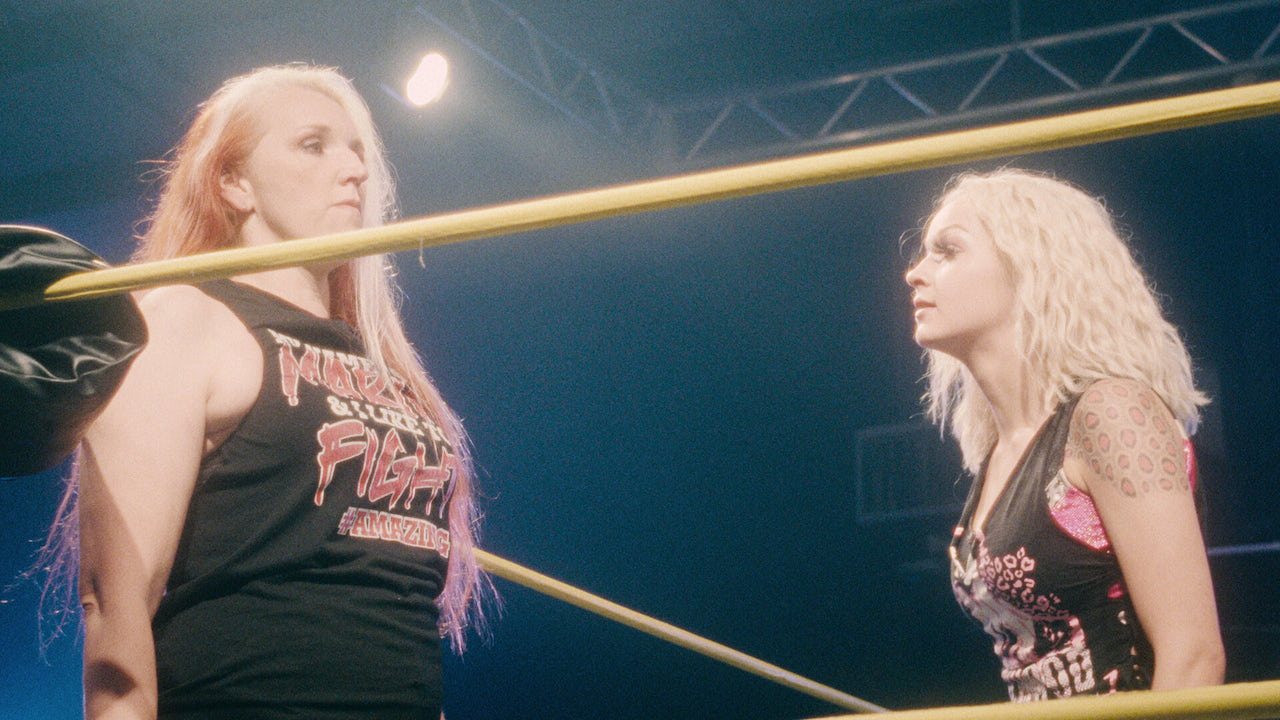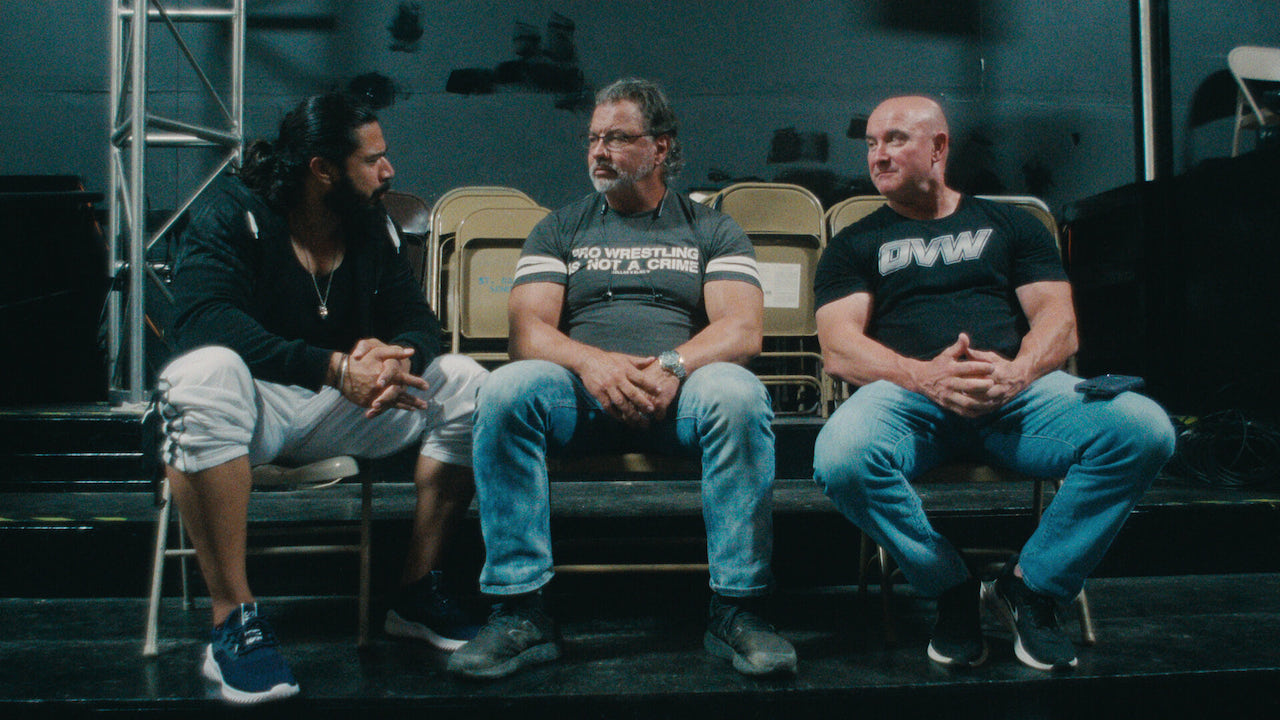Who cares if it’s real or not? The rousing reality TV triumph of Wrestlers

Choose your fighter: hard-done-by heroes, vulnerable villains, or their grizzled, ex-WWE legend of a boss. Eliza Janssen can’t get enough of Netflix’s Wrestlers, here highlighting two of the first season’s most special moments.
Wrestling is an art form I’ve always longed to get into. My most beloved reality TV obsession has always been RuPaul’s Drag Race: the heels, babyfaces, and outrageous soap opera storylines of the ring merely feel like a masc version of the same high-camp hysterics. As such, I was helpless to resist the appeal of Netflix’s latest athletic docuseries, from the same team behind Last Chance U and Cheer.
These programs make the most of intimate talking head interviews with relatively unprepared subjects. In those series, centered around college gridiron wannabes and cheerleaders, the spark of spontaneity came from each character’s youth: they’re green, but they’re aware that their fleeting time on the field, mat, what have you, could define their young lives.
Wrestlers is different, focusing on a down-on-its-luck Kentucky wrestling promotion that pitches itself as a cheap and nasty alternative to industry juggernaut WWE. Performers like Ca$h Flo and The Amazing Maria have already lived countless lives, won and lost more belts than a newcomer to the medium like me could ever fathom. Wrangled into the slick, inspiring format of a streaming service comeback saga, they’re perfectly primed for their big break…even if it’s arrived much later than they deserve. Spoilers ahead for some of season one’s biggest moments.
Series director Greg Whiteley knows just the larger-than-life character with whom to introduce us to the gnarly world of Ohio Valley Wrestling. “Hollyhood Haley J” is barely into her twenties, and is already OVW’s most loved/hated “heel”, channelling a childhood of resentment towards her absent mother into a loudmouth, bratty villain persona. I would not want to get in a car with Haley—Whiteley’s wide-eyed camera catches her texting and lighting up a joint while doing 100 on the highway—but she’s enduringly empathetic. She speaks frankly about how wrestling became a cathartic form of anger management after years of abandonment; sexual assault; poverty and encounters with gun crime as a teenage single mum.
The magic of kayfabe—a wrestling term for the constructed “reality” of storytelling in the ring—means that this tough, personal backstory is allowed to blossom into an action-packed, seemingly spontaneous smackdown by the end of Wrestlers’ pilot. Because Haley’s mother, Maria, is The Amazing Maria: a former heel herself, who now stage-manages every live OVW show. In a violent, emotionally confronting conclusion to the first episode, the mother and daughter stage an embittered, unscripted battle that clearly cuts close to home for both “performers”.

That’s inside the ring, though. In the offices of OVW and across each episode of Netflix’s polished depiction of the financially-shaky promotion’s make-or-break season, two titans wage a grander war of art versus commerce. They are Al Snow, former WWE legend and current, beleaguered OVW CEO: and Matt Jones, a wealthy sports radio pundit whose cash investment in OVW gives him a say in the ailing company’s direction.
Snow loves what he does, even if his perma-crossed arms and low growl of a voice don’t betray it often: “welcome to The Muppet Show”, he jokes as another chaotic live event kicks off; “I’m Kermit the Frog”. Jones, an outsider to OVW, loves the promotion’s potential to finally turn a buck. The comic books and Marvel figurines on Snow’s shelf say it all. This is a tried-and-true format, of talented heroes fighting back against the dark forces (of money, marketing, modernity) that seek to strip something wonderfully old-school of its identity.
Episode three turns that all around. While it’s clear that Matt Jones is merely trying to put OVW in the black, viewers will initially see him as a budget-fudging corporate heel without a costume. In a tense team meeting, Snow and the promotion’s other stalwarts try to lay down the law: Jones needs to treat the wrestlers with more respect, and appreciate that the old way has been keeping the lights on at OVW.
Then Jones’ ingratiating quips stop. Whiteley’s cameras circle nervously, unsure what is happening. Jones, who had not previously disclosed his epilepsy in the series’ one-on-one interviews, has a seizure, immediately making the gang’s dick-measuring banter of pay-per-view sales and locker room conflict totally unimportant.

I’m a big fan of horror movies, of scripted, graphic moments on screen. Jones’ sudden medical episode at the conclusion of Wrestlers’ third episode is one of the most shocking things I’ve ever seen on TV. Not because his illness is horrifying or unusual, or something to be shocked by—but because it harshly reminded me that this OTT, formulaic bad guy was, above all else, just a guy.
The rest of the docuseries follows a more straight-forward arc, drawing out fascinating biographies on each wrestler as we build to a classic sports movie happy ending. And yet we can’t shake this immensely human, vulnerable behind-the-scenes insight that the characters and production crew could never have seen coming. It disrupts the comfortable contours of the entertainment we expect from a low-key, country-fried wrestling smackdown, and from the manipulative editing of any true story made for Netflix.
Wrestlers is rife with gorgeous, glowy cinematography, often slo-mo’d for a lil extra epic spice, and features some grandiose hair metal hits on its soundtrack. The best reason to tune in, however, is for unpredictable emotional beats like that mother-daughter bout, or the thoughtful redemption of a slimy off-stage “villain”. This is as good as reality TV can get—seamlessly integrating smaller stories into one fist-pumping mosaic of a community that has long deserved its flowers. I can’t wait for the recently-announced season two: Mahabali Shera better take that Heavyweight Championship Belt in ’24.

















